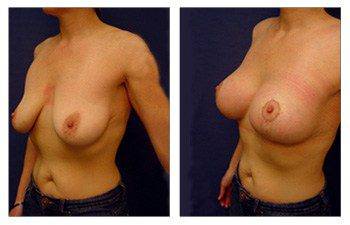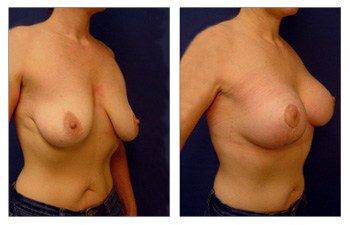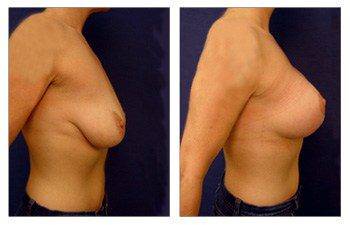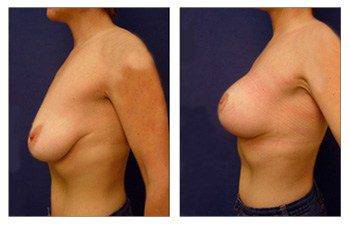





Intrinsic to breast lift with implant augmentation is that there are limitations. It is important for there to be an honest discussion and conversation between the patient and their surgeon about breast lift with implant augmentation limitations.
Although these limitations may not be a problem for each woman thought to have a breast lift with implant augmentation surgery, it is better to be well prepared with the expectations and limitations of the procedure.
It should be noted that with a breast lift with an implant augmentation procedure, there is a slight trade-off. This trade-off is between the sagging breasts and scars. These scars remain under the nipple so they are not visible in swimwear or clothing, and are for the most part concealed.
SurgiSculpt surgeons consider this a very light trade-off as having beautiful, lifted, full, symmetrical breasts will take away from scars that eventually fade. The main limitation of a breast lift with implant augmentation is what is called a vertical mastopexy. In doing a vertical mastopexy, we are limited as surgeons if the patient has much lower-placed breasts. If this is the case, as seen by the patient here, you can only lift the nipple up 5 cm.
Introduction: Navigating Breast Lift with Implant Augmentation: Recognizing Its Limitations
Breast lift with implant augmentation is a popular cosmetic procedure designed to enhance breast aesthetics and address concerns related to sagging and volume loss. While this combination surgery offers numerous benefits, it is essential to acknowledge its limitations. This essay explores the potential constraints and restrictions associated with breast lift with implant augmentation, offering insights into what patients can realistically expect from the procedure.
Understanding Breast Lift with Implant Augmentation
Breast lift with implant augmentation, also known as mastopexy-augmentation, is a surgical procedure that combines two techniques to enhance the appearance of the breasts:
- Breast Lift (Mastopexy): The breast lift component of the procedure aims to reshape and elevate the breasts. It involves the removal of excess skin, repositioning of the nipple-areola complex, and tightening of the breast tissue. The result is a firmer, more youthful breast appearance.
- Breast Implant Augmentation: Implants, typically silicone or saline, are inserted to increase breast volume and create a fuller, more youthful contour. The choice of implant size, shape, and profile is personalized to align with the patient’s aesthetic goals.
Limitations of Breast Lift with Implant Augmentation
- Scarring:
- One of the primary limitations of the procedure is the presence of scars. Incisions are made to reshape the breasts and accommodate the implants, resulting in various scar patterns. While surgeons aim to minimize scarring, patients must understand that scars are an inherent part of the procedure.
2. Limited Natural Tissue:
- The procedure relies on the existing breast tissue to support the implant. In cases of significant tissue loss due to aging, pregnancy, or weight fluctuations, there may be limitations on the size of the implant that can be accommodated while maintaining a natural look.
3. Lifespan of Implants:
- Breast implants are not lifetime devices and have a limited lifespan. Over time, they may need to be replaced or removed, requiring additional surgeries and expenses.
4. Potential for Complications:
- Like any surgical procedure, breast lift with implant augmentation carries a risk of complications, including infection, implant rupture, capsular contracture, and anesthesia-related risks. These complications can necessitate further surgeries.
5. Realistic Expectations:
- It is essential for patients to have realistic expectations. While the procedure can provide remarkable improvements, it may not achieve perfection. Breasts continue to change with time, and the aging process may affect the longevity of results.
6. Complex Recovery and Postoperative Care:
- The recovery and postoperative care process can be more complex than that of individual procedures. Patients must be diligent in following postoperative care instructions, which may involve specific scar care, implant massage, and activity restrictions.
7. Cost Considerations:
- Breast lift with implant augmentation is a significant financial investment. Patients should consider the initial costs, as well as potential future expenses associated with implant replacement or removal.
Scarring: A Considerable Limitation
- Scar Patterns:
- The type and extent of scarring are primary concerns for patients undergoing breast lift with implant augmentation. The procedure involves incisions to lift the breast tissue and insert the implants, resulting in scars. Common incision patterns include periareolar (around the areola), vertical (from the areola to the breast crease), and anchor-shaped (around the areola, vertically, and along the breast crease). The scar pattern chosen depends on the degree of breast sagging and the implant size.
2. Scarring Management:
- While surgeons employ techniques to minimize scarring, including precise incision closure and scar care instructions, patients must understand that scars will remain visible, especially in the early stages of recovery. Over time, scars may fade and become less noticeable.
3. Patient Education:
- Patient education is essential to ensure that individuals understand the trade-off between scarring and aesthetic improvements. Patients should be aware of potential scarring and manage their expectations accordingly.
Natural Tissue Limitations
- Limited Natural Tissue:
- The success of breast lift with implant augmentation largely depends on the amount of natural breast tissue available to support the implants. Patients with minimal breast tissue may have limitations on the size of implants that can be safely accommodated.
2. Risk of Overaugmentation:
- Overaugmentation, or using implants that are too large for the amount of natural breast tissue, can result in an unnatural and disproportionate appearance. Surgeons must carefully evaluate each patient’s unique anatomy to avoid this limitation.
3. Surgical Considerations:
- Surgeons should take into account the patient’s current breast size and shape, as well as the desired outcome, to determine the appropriate implant size and positioning. The goal is to achieve a harmonious and natural-looking result.
Lifespan of Implants
- Implant Longevity:
- Breast implants are not designed to last a lifetime. The lifespan of implants can vary, but most patients can expect them to last between 10 to 20 years. After this period, the risk of implant-related complications, such as rupture or leakage, increases.
2. Additional Surgeries:
- Patients should be prepared for the possibility of future surgeries to replace or remove implants. This can entail additional costs, downtime, and recovery periods.
Potential for Complications
- Implant-Related Complications:
- Breast lift with implant augmentation, like any surgical procedure, carries potential risks. Complications may include implant rupture, implant displacement, or capsular contracture. These issues may require surgical intervention for correction.
2. Anesthesia Risks:
- Anesthesia-related risks exist for any surgical procedure. Patients should be assessed for their suitability for anesthesia and understand the associated risks.
3. Infection and Wound Healing:
- Infection and wound healing issues can occur, potentially leading to complications and additional surgeries. Patients should follow postoperative care instructions to minimize these risks.
Realistic Expectations
- Aging Process:
- Patients should be aware that breasts continue to change with time, and the aging process may affect the longevity of results. While the procedure can provide significant improvements, it may not halt the natural aging process.
2. Life Events:
- Life events such as pregnancy, weight fluctuations, and hormonal changes can impact the appearance of the breasts. These factors may necessitate future surgeries or impact the longevity of the results.
3. Balance and Symmetry:
- Achieving perfect symmetry is challenging, and some degree of asymmetry may persist even after surgery. Patients must understand that the goal is to create balance and enhance aesthetics.
Complex Recovery and Postoperative Care
- Postoperative Care Complexity:
- The combined nature of breast lift with implant augmentation can result in a more complex recovery process compared to individual procedures. Patients must follow detailed postoperative care instructions to optimize healing and minimize complications.
2. Scar Care:
- Special attention to scar care is necessary to minimize the visibility of incision scars. Patients are often advised to use scar creams or ointments and avoid sun exposure on incision sites.
3. Implant Care:
- Patients with breast implants may require specific postoperative care, such as massaging the implants
Her breast mounds are beautiful, but in theory, you can lift the breasts and the nipples higher if the breasts are not sagging as much. For this reason, the patient presented here lacks medial cleavage. You can only get cleavage when the breast mounds are higher. Our patient here had breasts that were previously lower, and because cleavage is only created on the sternum, this is a breast lift with implant Our 40-year-old patient presented here demonstrates a bilateral breast lift with implant augmentation. With a vertical mastopexy, our patient had limitations in how high the nipples could be moved up but overall demonstrates a beautiful and improved breast contour.
